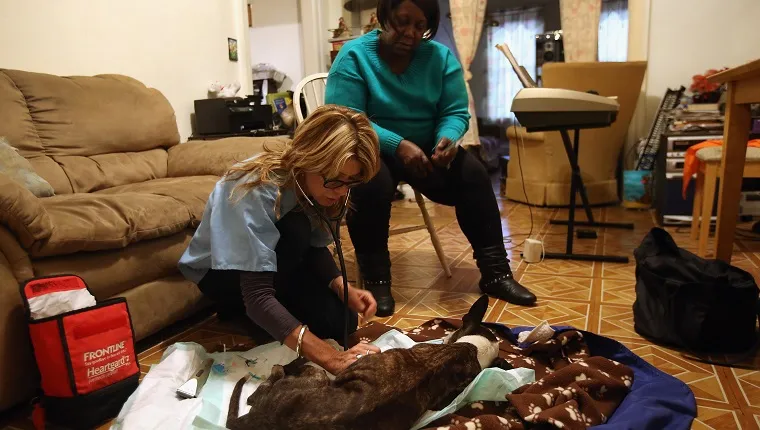Euthanasia is an overdose of barbiturates that will stop a dog’s heart. The fluids are administered through an intravenous catheter or an injection, and it is painless when done properly.
Many dog parents choose this option when their pets’ suffering becomes too great and there’s no possibility of recovery.
Certain animal shelters or city pounds may euthanize dogs, as well. Many shelters have moved to no-kill models and only euthanize in very specific circumstances.
When it’s your dog being euthanized, you can choose whether or not you want to be present. Some veterinarians will come to your home to administer euthanasia for your dog, which can be a good idea if your dog finds going to the clinic or pet hospital stressful.
Before the procedure, most vets will invite you to go into an examination room and then leave you alone for a few minutes to say what you want to say, or just hold your dog close. When the vet and vet tech come in, let them know whether you’d like a snippet of your dog’s fur or your dog’s collar to keep.
If you believe your dog is suffering and you’d like to end it painlessly and with love, you should discuss euthanasia as an option with your vet. They can give you advice and opinions; however, the decision will ultimately be up to you.
Here are a few things you should know about euthanasia for dogs.
What’s The Procedure For Dog Euthanasia?

Some clinics give the dog a sedative first because many grow anxious before the procedure. However, it isn’t standard practice everywhere, so you may have to ask for it if your dog is being euthanized.
Most vets use a seizure medication called pentobarbital, which causes the heart and brain to shut down when given in high doses. This is administered intravenously.
Certain dogs, like some humans, are more reactive to needles than others and will whine or vocalize in response to the injection, which can be disconcerting, to say the least, at a time when emotions are already fraught.
What most people are not prepared for is how quickly the euthanasia solution works; death occurs in just a few seconds. You’ll probably feel your dog relax, and then it’s over.
Sometimes you may hear what sounds like a gasp coming from your dog after they’ve passed; that’s simply air being exhaled by the lungs. The nerves can twitch for a moment, too. Sometimes the bladder evacuates.
These are involuntary reflex actions after death and aren’t painful, but they can be disturbing to watch. Unlike in the movies, your dog’s eyes will probably not close automatically.
Which Dogs Get Euthanized?

Some shelters put down dogs that they consider unadoptable. These can include dogs who have aggressive tendencies, dogs who are too old, dogs who have illnesses or deformities, or dogs who remain at the shelter for too long.
No-kill shelters seek to place every dog who comes into their care with loving homes, though there are still circumstances where they may choose to euthanize. Dogs deemed dangerous by a court after a bite incident or those who show serious signs of aggression can be sentenced to euthanasia, as well.
Euthanasia can also be a humane way of ending the life of a dog who is suffering.
As for whether or not you should euthanize your own dog, there are many questions you need to ask yourself.
Is your dog sick with no hope of getting better? Is your dog unable to maintain basic functions such as eating, moving, going potty, or sleeping through the night? Are they in pain?
Discuss these questions with your vet before you make a decision. When you do decide, you’ll be doing it for the right reasons.
Should I Be There When My Dog Is Euthanized?

The only right answer is the one that makes sense for you. Your dog would probably appreciate you being there, as painful as it may be, but it is your choice.
If you feel your children won’t understand or think you’re harming the dog, or if their own emotions will upset the dog, it may be best not to have them there. For a mature child who asks to be present, it might be fine.
You can always ask for your vet’s opinion, as well.
However, you should keep in mind that many dogs look for their humans in this circumstance. The procedure can frighten them, and they will search for you as a source of comfort. When you are not there, their final moments can grow even more unpleasant.
Burial Options

Even though you may feel emotionally incapable of making any more decisions, try deciding beforehand what to do with your dog’s remains.
If you haven’t made burial arrangements in advance, your clinic can provide group cremation (in which you do not receive any ashes), individual cremation (in which your dog’s ashes are returned to you), or you can bury the body. An autopsy can be performed with any of these choices.
Be aware that municipalities have regulations about whether or not pets can legally be buried there. While it’s not usually a concern in rural areas, it’s typically illegal in cities.
Euthanasia can be a humane option to end suffering. It can provide your dog a peaceful, painless passing surrounded by loved ones, which is more than most of us could hope for. Though it may be painful to say goodbye, you’ll need to decide what is the right thing to do for your beloved dog.
Have you ever said goodbye to a dog you loved? How did you decide when the time was right? Join the discussion in the comments below.









